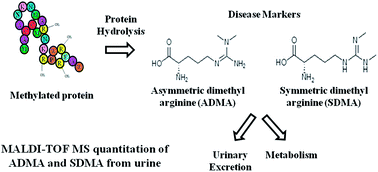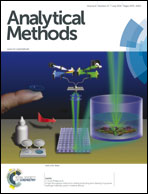Matrix-assisted laser desorption/ionization mass spectrometry analysis of dimethyl arginine isomers from urine†
Abstract
Isomeric asymmetric and symmetric dimethyl arginine (ADMA and SDMA respectively) residues are excreted in urine and are putative markers of cardiovascular and chronic kidney diseases. In this work, we demonstrate simultaneous and quantitative detection of endogeneous ADMA and SDMA from urine samples of healthy subjects using MALDI-TOF MS without any chromatographic separation. The DMA isomers yielded [M + H]+ ions along with their product ions formed due to MALDI in-source fragmentation. The precursor ions were validated using MALDI-TOF MS/MS as well as direct injection ESI-Q-TOF MS/MS. ADMA and SDMA generated unique product ions at ∼ m/z 46 and ∼ m/z 172 respectively in the MS-mode itself. These were advantageously used for full scan-mode absolute quantification of the isomeric metabolites. The m/z observed for all the ions was within 10 ppm mass accuracy. The calibration method was established by generating internal standard normalized peak area-based concentration response curves using synthetic standards. Good linearities (R2 > 0.95) with acceptable intra-assay, inter-assay variation (within 15% RSD) and excellent recoveries were observed for quality control samples. Finally, endogeneous concentrations of the metabolites were determined in urine from healthy subjects (n = 11). ADMA and SDMA were found to be in the range of 1.6–8 μM and 2.9–9.1 μM in urine and were in agreement with previously reported physiological levels.


 Please wait while we load your content...
Please wait while we load your content...